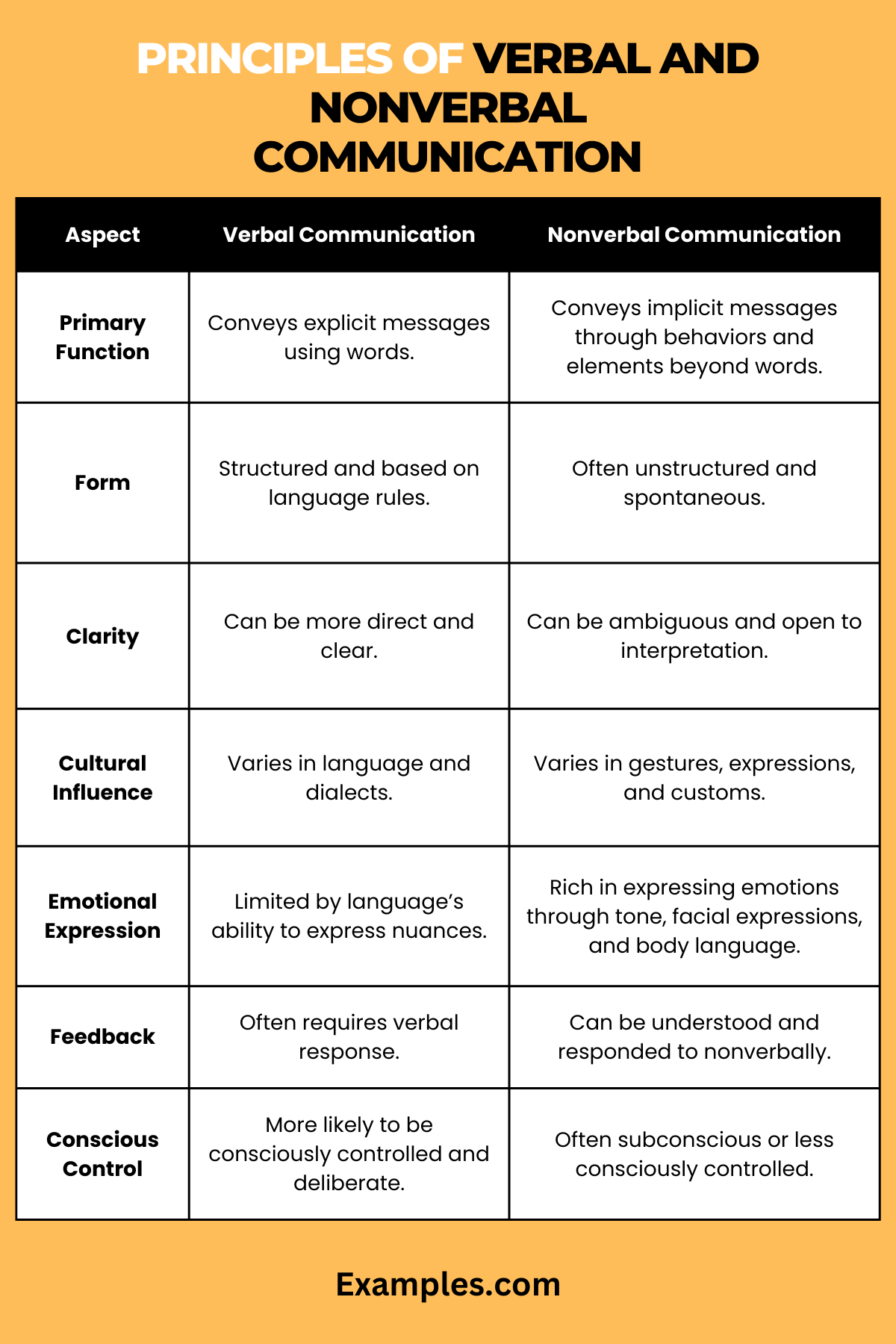Principles of Nonverbal Communication Examples
Understanding the Principles of Nonverbal Communication is crucial for effective interpersonal interactions. This comprehensive guide delves into the subtleties of unspoken cues, exploring various Nonverbal Communication Examples to illustrate key concepts. From facial expressions to body language, we cover the essential aspects that convey meaning beyond words. Enhance your communication skills by mastering these principles, integral in both personal and professional settings. Learn to interpret and utilize nonverbal signals for more impactful and meaningful connections.
What are the Principles of Nonverbal Communication? – Definition
Nonverbal Communication encompasses all forms of communication that do not involve words. This includes facial expressions, body movements, gestures, eye contact, posture, and even the use of space. It’s a powerful aspect of how we convey and interpret messages. Nonverbal cues often express more than spoken words, offering insights into emotions, intentions, and attitudes. Understanding these principles is key in interpreting and effectively using nonverbal signals in daily communication.
What are the Principles of Nonverbal Communication?
Nonverbal Communication is a critical aspect of how we interact and understand each other, often carrying more weight than verbal communication. The principles of nonverbal communication are diverse and complex, including:
- Contextual Understanding: Nonverbal cues are highly dependent on the context. For example, a gesture that is positive in one culture might be offensive in another. Understanding the context is key to interpreting nonverbal signals accurately.
- Cultural Influence: Different cultures have unique nonverbal communication norms. For instance, the meaning of eye contact varies widely across cultures. A thorough understanding of these cultural nuances is essential, especially in our increasingly globalized world.
- Involuntary Nature: Many nonverbal cues are involuntary and can reveal genuine emotions and thoughts. Facial Expressions in Nonverbal Communication are often the most telling, as they can subtly convey a wide range of feelings.
- Complementing Verbal Messages: Nonverbal communication often complements verbal messages, adding depth and emotion. For instance, a reassuring touch can enhance a comforting verbal message.
- Ambiguity and Interpretation: Nonverbal communication can be ambiguous and open to interpretation, making it essential to consider all aspects of the situation. For example, Fidgeting in Body Language might indicate nervousness or just a habit.
- Consistency and Congruence: The consistency between verbal and nonverbal messages is crucial. Incongruence can lead to misunderstandings or mistrust, while consistency enhances the clarity and credibility of communication.
By understanding these principles, individuals can improve their ability to interpret and convey messages effectively, enhancing their Nonverbal Communication Skills in both personal and professional settings.
Principles of Verbal and Nonverbal Communication
The interplay between Verbal and Nonverbal Communication forms the backbone of effective communication. These principles help in understanding how different aspects of communication work together:

| Aspect | Verbal Communication | Nonverbal Communication |
|---|---|---|
| Primary Function | Conveys explicit messages using words. | Conveys implicit messages through behaviors and elements beyond words. |
| Form | Structured and based on language rules. | Often unstructured and spontaneous. |
| Clarity | Can be more direct and clear. | Can be ambiguous and open to interpretation. |
| Cultural Influence | Varies in language and dialects. | Varies in gestures, expressions, and customs. |
| Emotional Expression | Limited by language’s ability to express nuances. | Rich in expressing emotions through tone, facial expressions, and body language. |
| Feedback | Often requires verbal response. | Can be understood and responded to nonverbally. |
| Conscious Control | More likely to be consciously controlled and deliberate. | Often subconscious or less consciously controlled. |
- Complementary Nature: Verbal and nonverbal communications often complement each other. For example, a smile combined with a positive statement can enhance the warmth of the message.
- Contradiction and Conflict: Sometimes, nonverbal cues may contradict verbal messages, which can indicate conflict or deceit. Recognizing such contradictions is crucial in understanding the true message.
- Substitution for Verbal Messages: Nonverbal cues can sometimes substitute for words. Nods or hand gestures can effectively convey agreement or direction without verbalization.
- Accentuation and Emphasis: Gestures, facial expressions, and tone can accentuate or emphasize parts of the verbal message, making it more impactful. For example, pounding a fist on a table can underscore a verbal point strongly.
- Regulation of Interactions: Nonverbal cues play a significant role in regulating conversational flow, indicating when it’s someone else’s turn to speak or when a topic change is needed.
- Consistency for Trust and Clarity: Consistent verbal and nonverbal messages build trust and clarity in communication. Discrepancies can lead to confusion and mistrust.
Mastering the principles of both verbal and nonverbal communication enables individuals to engage more effectively and authentically in various interactions, from Nonverbal Communication in Daily Life to professional engagements.
Types & Principles of Nonverbal Communication
Understanding the various Types of Nonverbal Communication is crucial for interpreting and effectively using nonverbal cues. These types include:

- Facial Expressions: One of the most expressive forms of nonverbal communication. Facial expressions can convey emotions like happiness, anger, or sadness, often transcending language barriers.
- Body Language: This involves posture, stance, and the way we carry ourselves. Body Language in Nonverbal Communication can reveal confidence, nervousness, or openness.
- Gestures: Hand movements and gestures can communicate a range of messages, from agreement (like nodding) to commands or emphasis.
- Eye Contact: The use and avoidance of eye contact can communicate honesty, interest, or discomfort.
- Touch (Haptics): Physical touch, like a handshake or pat on the back, can convey warmth, reassurance, or sympathy.
- Space (Proxemics): The physical distance maintained in interactions can indicate familiarity, intimacy, or authority.
- Vocalics (Paralanguage): This encompasses the tone, pitch, and volume of voice, conveying attitudes or emotions beyond the spoken words.
These types are governed by key principles that help in understanding and effectively utilizing nonverbal communication.
Key Principles of Nonverbal Communication
The Key Principles of Nonverbal Communication provide a framework for understanding how nonverbal cues complement and enhance verbal messages:
- Consistency: The alignment of verbal and nonverbal messages is vital. Inconsistencies can lead to misunderstandings or a lack of trust.
- Contextual Interpretation: Nonverbal cues should always be interpreted in context, considering the situation, relationships, and cultural backgrounds.
- Cultural Sensitivity: Being aware of cultural differences in nonverbal communication is crucial, as gestures or expressions can have different meanings in different cultures.
- Emotional Expression: Nonverbal communication is often a more genuine indicator of a person’s emotions and attitudes than their words.
- Subconscious Signals: Many nonverbal cues are given and received subconsciously, making self-awareness and observation essential skills.
- Complementing and Contradicting: Nonverbal communication can complement or contradict what is being said verbally, providing a deeper understanding of the speaker’s true message.
By understanding these types and principles, individuals can enhance their Nonverbal Communication Skills, allowing for more effective and empathetic interactions in various settings, from personal relationships to professional environments.
In conclusion, mastering the Principles of Nonverbal Communication is pivotal for effective interactions. This guide underscores the importance of understanding facial expressions, body language, and cultural nuances. By honing these skills, one can communicate more effectively and empathetically, ensuring messages are conveyed and received with clarity and accuracy. Embrace these principles to enhance your communication repertoire in all aspects of life.



